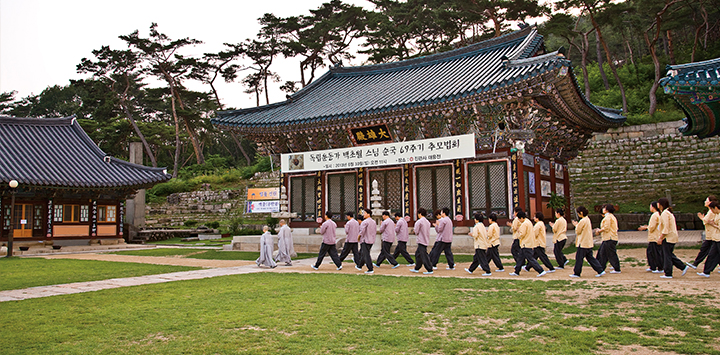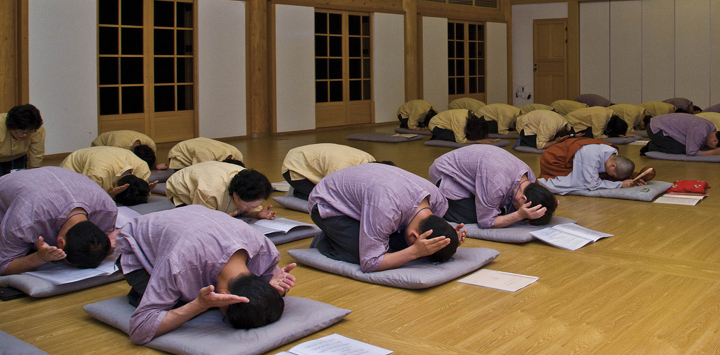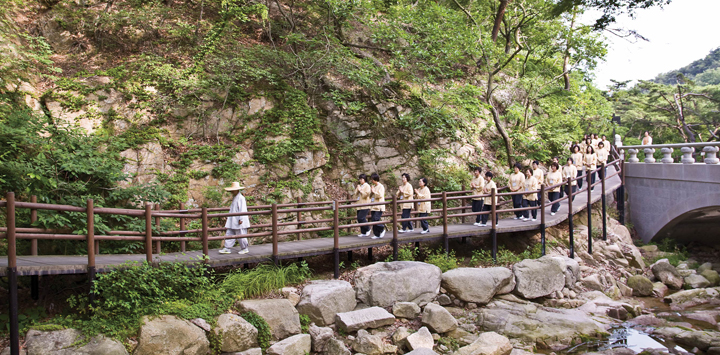What is a Temple Stay?
Temple Stay is a program to experience the life of a Buddhist monk and a daily routine at a Buddhist temple, provided in a well-preserved temple that has kept the origins and basics of the Buddhist culture, the repository of Korean tradition。
While the moon body and village that was tired temple natural environment and Buddhist culture is in harmony vivid, it is to experience our traditional culture。
It is a beautiful journey to set out for, with nature traditional culture, which has inherited the thousand years looking true to become free from the one has been secular worldly desires "true self"。
It is open to all people including non-Buddhists and foreigners。

About the Program
- ◈ Programs for Disciplining the Mind
- ▣ About the Temple
- Our culture and history, has a close relationship with South Korea Buddhism. Culture of the temple, has been directly inherited the spirit cultural traditions of South Korea, and was carried out on the basis of the idea and the natural affinity of life respected。
Jingwansa was founded by King Hyunjong, the 8th King of Goryeo Dynasty, and it is an ancient temple over a thousand years old. At Jingwansa, there are many tangible cultural heritage and cultural assets materials that narrate the history。
- ▣ Dawn Buddhist Service (Worship)
- Temple of the day will be started in the early morning of worship. Brush cutter is located three times a day, dawn of worship will at around 18:00 to 7:00 of time well by the evening of worship in the time 3:00 to 4:00 am. Brush cutter will be a courtesy to greeting Buddhists (believers) including the Sakyamuni Buddha. To brush cutter has meaning is rice look back their execution in the sense of respect for Buddha。
At Jingwansa, in the early morning of worship, 5 burning incense and the Balwonmoon by Isan Hyeyeon Sunsa and the Heart Sutra; in the evening worship, the Pure Land Ideology worship and Heart Sutra。
Zen meditation that becomes the main of ascetic method of Korea Buddhism in those Umusa (repeating dictation) the Sanskrit de Yana (dhyana), and beyond the life and death (life and death), nothing find my freedom, true forever is not clogged you can be defined as "a feeling wiped with depth of reason" for。
To learn the Zen of basic, via a direct Zen meditation, in a pure concentration and observation, it's time to look at the real sense of the world as soon as it is possible to meet the "true self"。
- ▣ Zen meditation
- Zen meditation that becomes the main of ascetic method of Korea Buddhism in those Umusa (repeating dictation) the Sanskrit de Yana (dhyana), and beyond the life and death (life and death), nothing find my freedom, true forever is not clogged you can be defined as "a feeling wiped with depth of reason" for。
To learn the Zen of basic, via a direct Zen meditation, in a pure concentration and observation, it's time to look at the real sense of the world as soon as it is possible to meet the "true self"。
- ▣ Tea Talk
- Drinking infused tea it is also called Dasun Ilmee (Tea and Zen), because it tastes like Zen. This is, if you do not have mental focus in the correct mind when it is in the month the car, because you can not be issued firmly its taste and color and aroma. While drinking tea, while examining the aroma and color and taste, is quiet and allowed to mature the spirit and the mind, to pursue the truth, if it leads to enlightenment, and the elders said this is exactly the Zen。
It's time to talk while drinking infused tea
- ▣ Buddhist Meal with Traditional Bowls (Balu)
- Balu means Traditional bowls (self-sufficient device), namely bowls that would fit one’s appetite. Balu, in addition to lyrics and sutras, has slightly varied through time from Sakyamuni Buddha until now, however, its appearance and consciousness has been handed down to this in the most traditional way and is currently one of the most original thing that represents Buddhism。
Through Balu, one will learn the wisdom of non-ownership and understanding of an ascetic。
- ▣ Community work (Wool Lyuk)
- In the section have a life of the masses, there are three types if necessary to defend sure. It is a memorial service and Wool Lyuk and worship. Wool Lyuk, in the sense that more than one person to work by joining forces, and established a herbs gathered all of dissemination to live in the section, to clean the magnanimity, and the necessary labor, such as maintenance is the time. Wool Lyuk is not only working, it is an ascetic。
Through interaction with nature and through the Wool Lyuk, they become vital source of life for static other implementation activities, none of this of harmony together, also you may look back their execution。
- ▣ 108 Bows
- Bowing is done to express utmost respect for the opponent and Sambo (Buddhism, Monk, and Law), and is one of how to run it in order to lower the myself (ulterior motives)。
One Archimonk had previously said that 108 bows has been an act of emptying one’s ‘filth bucket’. It Execution of honor exposed what truth bright put the darkness that has been put to myself is this section。

- ◈ Various Fun Programs
- ▣ Temple Food Experience Program
- Features of temple food is close to a vegetarian diet where you eat wild grass for food, without meat and Oshinche (five spices: garlic, green onion, onion, wild garlic, and chives), that give clean and refreshing taste, full of nutrition. On the basis of the basic spirit of Buddhism, and has made the frontiers of distinctive taste that is alive is natural flavor a simple and rustic materials. In the temple, is one way of creating a food process is also run。
- ▣ Walking Meditation (An Hang)
- Walking meditation (An Hang) is origin of Buddha and his disciples were examined by reason the truth while walking after Zen run. While silence in the woods, walking slowly, be aware concentrate on action to walk, you can hear the sounds of nature, and why a certain theme. It is an ascetic method to contemplate the body and mind while walking。
- ▣ Making Lotus Flower Lamps
- Lamp memorial service has been considered an important ritual in Buddhism along with the Incense memorial. Merit that you create such as cordially is that the sow merit only big wisdom of species, say it with a like. And pray for peace of the family and the people around you will create such carefulness with a lotus flower。
※ Other various traditional and Buddhist programs available。

Schedule
- ◈ Schedule (1 night)
- ▣ Basic
-
| 日期 |
时间 |
节目 |
内容 |
| 第一天 |
14:00 |
登记及入房 |
确认任务表 |
| 15:00 |
入院仪式 |
介绍寺院礼节和寺院概况 |
| 17:00 |
日落斋饭 |
在食堂吃斋饭 |
| 18:00 |
日落礼佛 |
(夏季:7点) |
| 20:00 |
禅舞冥想 |
做禅舞冥想 |
| 21:00 |
洗漱及入寝 |
洗漱、入寝 |
| 第二天 |
03:00 |
清晨礼佛 |
清晨礼佛 |
| 04:00 |
108拜 / 参禅 |
探索幸福的108拜 /参禅 |
| 06:00 |
钵盂斋饭 |
学习无所有和自然环境 |
| 07:00 |
布行(安行) |
在清晨时间做林间道冥想 |
| 08:00 |
与法师的对话 |
由法师朗读经文或进行茶谈 |
| 08:40 |
运役 |
整理自己的坐席 |
| 09:30 |
回向仪式 |
填写问卷及拍纪念照 |
※Schedule details are subject to change。
 HOME > 心灵治愈与解毒疗法 > Temple Stay at Jingwansa
HOME > 心灵治愈与解毒疗法 > Temple Stay at Jingwansa

